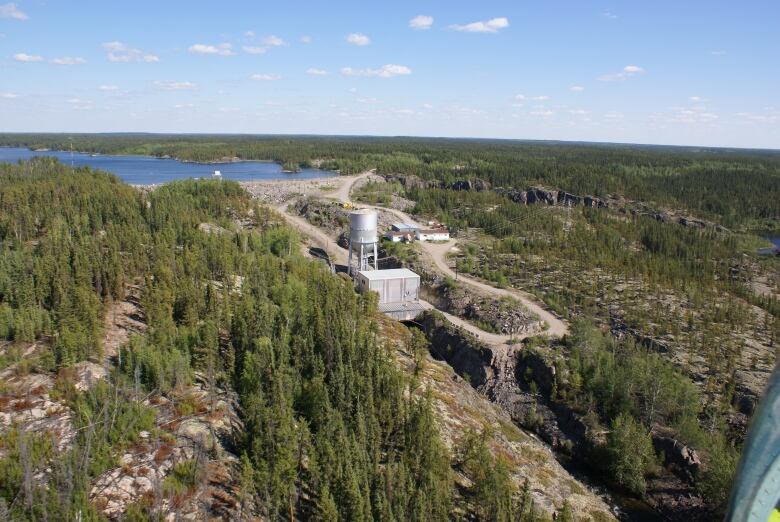MLA doubtful Taltson project will help N.W.T. achieve its climate goals
Expansion project relies on fluctuating mining industry to buy power

An N.W.T. MLA says an ambitious energy project likely won't be built in time for the N.W.T. to meet its greenhouse gas emission reduction targets.
The first phase of the Taltson hydro expansion aims to build a new 60-megawatt power plant next to the existing Twin Gorges facility northeast of Fort Smith and then connect it to the North Slave Hydro System either through or around Great Slave Lake.
The territory has been relying on the project to come online by 2030to meet its reduction targets but, as Yellowknife North MLA Rylund Johnson pointed out at the Legislative Assembly last month, it hinges on a number of things including three more mines coming online and agreeing to buy power.
"The mining world is boom and bust, and it's hard to get three mines to open, let alone sign on and commit to purchasing power in the long-term," Johnson said in an interview.He said it's "really unlikely" construction will be done by 2030, and it's a toss up whether construction will have begun by then.

Andrew Stewart, N.W.T.'s director of strategic energy, said the expansion willrequire two or three modestly-sized mines to sign on ascustomers. He said the "prospects of new mining developments are certainly there" and the territory is looking at nine candidates: Yellowknife City Gold, Yellowknife Gold, Nechalacho mine, Pine Point, NICO, Colomac, Ekati mine, Gahcho Kue mine and Courageous Lake.
However, he also noted thedistance to the territory's three operating diamond mines, deep in the Slave Geological Province (Ekati, Gahcho Kue and Diavik)would make for a "challenging" business case and the expansion would require customers close to existing infrastructure.
Support from Ottawa 'exciting' says department
Phase one of the Taltson expansion is slated to cost $1.5 billion.
Stewart said the territory continues to use the $18 million it secured in the 2019 federal budget to investigate the feasibility of the project. He said there's enough money to get to a regulatory application, but the territory is going to need between $25-30 million more to get through a multi-year regulatory approval process.
"We don't have enough to get that construction decision," he said.
Early last month, Cabin Radio reported that Dominic LeBlanc, the federal infrastructure minister, said he saw a "very clear path" to funding the expansion.

Stewart said the federal government has been putting its money where its mouth is for the past number of years by investing in the feasibility stage of the project, and that it's "very exciting" to hear Ottawa is supportive.
When asked whether the Taltson would be built by 2030, Stewart said: "That's the path we're on." He also said there are lots of questions left to be answered, and the support of Indigenous partners, as well as the territorial and federal governments, will be critical moving forward.
Diamond mines slated to close before Taltson is built
The N.W.T. has to reduce its greenhouse gas emissions by 193 kilotonnes in order to hit its 2030 reduction target on top of actions laid out in the territory's 2019-2022 Energy Action Plan.
Infrastructure Minister Diane Archie told the Legislative Assembly on May 26 the territory would notupdate its target, which has fallen out of line with Canada's commitment. (That's a change from when Environment Minister Shane Thompson last year said the N.W.T. wasn't saying "yes or no" to updating the goals).
The territory says the first phase of theexpansion is expected to reduce greenhouse gas emissions by 227 kilotonnes a year byreducing or displacing diesel with hydropower at new and existing mines.But Johnson says that is based on an old vision of supplying power to diamond mines which, he noted,is no longer part of the conversation.
The territory's three diamond mines will all, currently, come to an end by 2030.

"All of our documents pretend like we're building the Taltson by 2030 and the diamond mines will be hooked up, so we're going to get a giant reduction. And I even assume they're telling the feds that, which is why the feds are interested," said Johnson.
What the Taltson expansion will do, he said, is provide futuremines that may have used diesel with hydro power instead.
Archie declined to do an interview with CBC News.When CBC News asked Archie via email what the territory would do to meet its goalsif the Taltson was not built on time, a spokesperson re-directed the questions to the infrastructure department saying they were "operational in nature."
A spokesperson for the department said the upcoming energy action plan will introduce new initiatives and measures to keep the territory "on track."
A missed opportunity
Back when the Taltson expansion was first being conceptualized, Johnson said it was probably true that it could have significantly reduced the territory's greenhouse gas emissions and created one of the greenest mining economies in the world.
Now, he said, the territory is two decades too late.
"It's like they've just kind of given up. They had Taltson as this silver bullet for a long time." he said.
"It's now kind of realizing that with diamond mines winding down, it's not going to be. And they seem to have no plans to do anything else."












_(720p).jpg)


 OFFICIAL HD MUSIC VIDEO.jpg)
.jpg)



























































































